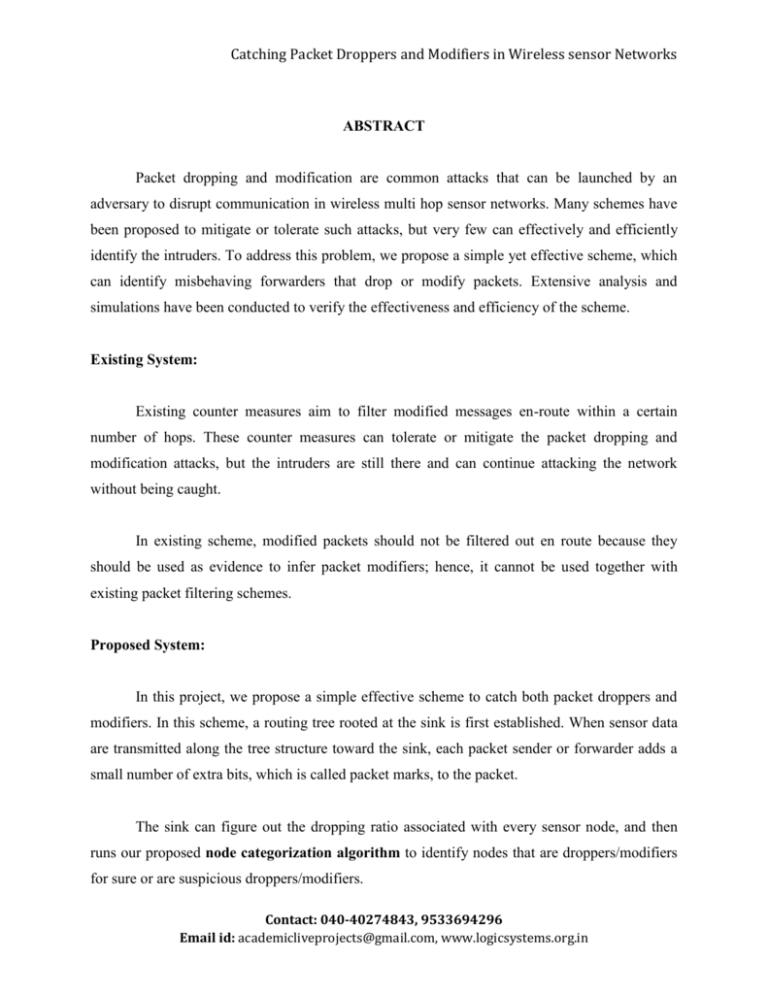Catching Packet Droppers and Modifiers in Wireless sensor
advertisement

Catching Packet Droppers and Modifiers in Wireless sensor Networks ABSTRACT Packet dropping and modification are common attacks that can be launched by an adversary to disrupt communication in wireless multi hop sensor networks. Many schemes have been proposed to mitigate or tolerate such attacks, but very few can effectively and efficiently identify the intruders. To address this problem, we propose a simple yet effective scheme, which can identify misbehaving forwarders that drop or modify packets. Extensive analysis and simulations have been conducted to verify the effectiveness and efficiency of the scheme. Existing System: Existing counter measures aim to filter modified messages en-route within a certain number of hops. These counter measures can tolerate or mitigate the packet dropping and modification attacks, but the intruders are still there and can continue attacking the network without being caught. In existing scheme, modified packets should not be filtered out en route because they should be used as evidence to infer packet modifiers; hence, it cannot be used together with existing packet filtering schemes. Proposed System: In this project, we propose a simple effective scheme to catch both packet droppers and modifiers. In this scheme, a routing tree rooted at the sink is first established. When sensor data are transmitted along the tree structure toward the sink, each packet sender or forwarder adds a small number of extra bits, which is called packet marks, to the packet. The sink can figure out the dropping ratio associated with every sensor node, and then runs our proposed node categorization algorithm to identify nodes that are droppers/modifiers for sure or are suspicious droppers/modifiers. Contact: 040-40274843, 9533694296 Email id: academicliveprojects@gmail.com, www.logicsystems.org.in Catching Packet Droppers and Modifiers in Wireless sensor Networks Specifically, based on the packet marks, the sink can figure out the dropping ratio associated with every sensor node, and then runs our proposed node categorization algorithm to identify nodes that are droppers/modifiers for sure or are suspicious droppers/modifiers. As the information of node behaviors has been accumulated, the sink periodically runs our proposed heuristic ranking algorithms to identify most likely bad nodes from suspiciously bad nodes. This way, most of the bad nodes can be gradually identified with small false positive. List of modules: 1. Node Configuration a. Link Configuration 2. Sender Node a. Packet Splitting b. Send Packets to Intermediate 3. Intermediate Node a. Send Packets to Sink b. Modify or Drop 4. Sink a. Verify b. Merge Packets c. Categorization And Ranking Contact: 040-40274843, 9533694296 Email id: academicliveprojects@gmail.com, www.logicsystems.org.in Catching Packet Droppers and Modifiers in Wireless sensor Networks Module Description: 1. Node Configuration a. Link Configuration In this module Nodes are configured based on number of nodes in group. We create the network group by connecting nodes to sink. Link configuration means connecting the nodes and intermediate nodes to the sink. 2. Sender Node a. Packet Splitting In this module, Sender selects the file which is to be sent. And then it split into the number of packets based on the size for adding some bits in it. b. Send Packets to Intermediate And then it encrypts all the splitted packets. And then sender adds some bits to each encrypted packets before sending that. Bit Addition for each packet is identification for sender. After adding of bits to each packet, it sends the packets to the nearest node or intermediate node. 3. Intermediate Node Contact: 040-40274843, 9533694296 Email id: academicliveprojects@gmail.com, www.logicsystems.org.in Catching Packet Droppers and Modifiers in Wireless sensor Networks a. Send Packets to Sink In this module, the intermediate node receives Packets from the sender. After receiving all packets from sender, it encrypts all packets again for authentication. Before sending to sink, intermediate add some bits to each packet for node identification. After adding some bits from intermediate, it sends all packets to the sink. b. Modify or Drop Before sending all packets to sink, packets dropping or packets modifying may be occur in intermediate. 4. Sink a. Verify In this module, Sink receives all packets from the sender node, and it verifies all packets which are dropped or not. And it also verifies the packets which are modified or not and it can identify the modifiers in the process based on the bit identification. b. Merge Packets After receiving all packets in sink, it decrypts all packets. After the decryption if there is no modified or dropped packets, it merge all packets. After merging, Sink can receive the original file. c. Categorization And Ranking In this module Categorization and Ranking will be performed based on the node behavior. If there is any modification or drop of packets in node it assumes negative Contact: 040-40274843, 9533694296 Email id: academicliveprojects@gmail.com, www.logicsystems.org.in Catching Packet Droppers and Modifiers in Wireless sensor Networks value for modifier or dropper. Sink performs Ranking for each node based on the Category of nodes. Sink gives ranking like Good, Temporarily Good, Suspiciously Bad, Bad based on the node behavior in the process Node Configuration: Level-0 Sink Level-1 Node1 Node2 Level-2 Node3 Node4 Node5 Node6 Contact: 040-40274843, 9533694296 Email id: academicliveprojects@gmail.com, www.logicsystems.org.in Catching Packet Droppers and Modifiers in Wireless sensor Networks System Requirements Specification: Software Specification: Front End : JAVA JDK : 1.6 Back End : MYSQL Hard ware Specification: Operating System : Windows XP RAM : 512MB Hard Disk : 50GB Contact: 040-40274843, 9533694296 Email id: academicliveprojects@gmail.com, www.logicsystems.org.in







